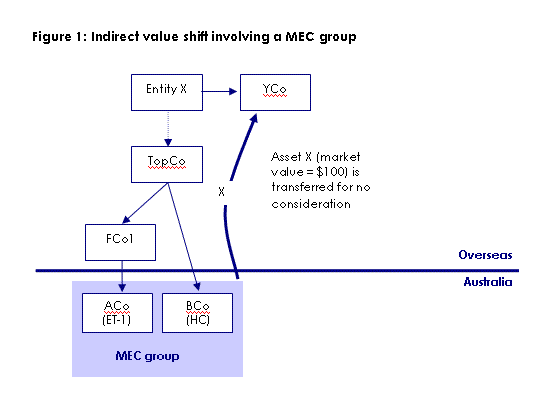Consolidation Reference Manual
You can still refer to the Consolidation reference manual for consolidation information that has not been impacted by changes in the legislation.
C2 Assets
C2-6 Loss integrity measures and general value shifting regime
C2-6-170 General value shifting regime (GVSR)
The general value shifting regime (GVSR) contained in Divisions 723, 725 and 727 of the Income Tax Assessment Act 1997 (ITAA 1997) includes rules for created rights, and direct and indirect value shifting. These rules replace the previous value shifting rules in Divisions 138, 139 and 140 of the ITAA 1997.
Broadly, the new Divisions apply from 1 July 2002 to all entities including those with substituted accounting periods. The previous rules continue to apply to value shifts that happened before 1 July 2002.
The single entity rule means that the GVSR has no impact for interests within consolidated and MEC groups during consolidation. Value shifting integrity issues are addressed by the methods used to reconstruct the cost bases of interests in entities leaving the group (e.g. under Division 711). Generally, direct and indirect interests held by non-group members in a consolidated or multiple entry consolidated (MEC) group are not subject to the provisions of Part 3-90. Such interests are subject to the GVSR or the loss reduction method.
New GVSR rules
New rules have been introduced so that the GVSR applies appropriately when a consolidated or MEC group is involved in a value shift - for example, when a head company transfers an asset to an associated non-group member for less than its market value. These rules include the loss reduction method.
→ 'Application of the loss reduction method to consolidated and MEC groups', C2-6-160
The effect of the single entity rule is that intragroup value shifts are disregarded for the purposes of determining the tax liability or losses of the head company. Value shifting integrity is generally achieved within a consolidated or MEC group by the combined operation of the single entity rule and cost setting (including pooling) rules. For example, the cost setting reconstruction rules for membership interests and loans when an entity leaves a consolidated group relate to assets that leave with the entity (disregarding assets that have left the entity in a value shifting transaction).
Broadly speaking, Divisions 723, 725 and 727 have no impact on intragroup value shifts.
The indirect value shifting rules in Division 727 do not deal with the effects of value shifts on interests in group members when the value shift is between the group and a related entity and the effects are subject to consolidation rules. There may, however, be an effect when a shift in value out of the group impacts on the value of interests in the group that are held by a non-consolidated controller of the group (e.g. a non-resident that directly owns a resident head company).
Consolidated groups
The single entity rule and entry history rule have been extended for the purposes of the GVSR. Two of the consequences for the indirect value shifting rules are that the head company is the only group entity that can be a losing entity or gaining entity, and it will be considered to have provided or received any economic benefits.
Indirect value shifting rules apply normally in most situations. However, only interests in the head company of the consolidated group are affected by these rules. Other interests are covered by the loss reduction method or Division 711 (e.g. those in a transitional foreign-held subsidiary).
Generally, the GVSR does not apply to interests covered by the loss reduction method.
MEC groups
The single entity rule and entry history rule have been extended for the purposes of the GVSR.
Indirect value shifting rules apply normally in most situations. However, only interests in the top company of the MEC group, and pooled interests in the eligible tier-1 companies, can be affected by these rules. Other interests are covered by the loss reduction method or Division 711 (e.g. interest in a transitional foreign-held subsidiary). The method of making adjustments to pooled interests has also changed.
Generally, the GVSR does not apply to interests covered by the loss reduction method.
Example: indirect value shift involving a MEC group
Figure 1 shows an example of an indirect value shift involving a MEC group.
In the example, entity X holds 80% of the equity interests in TopCo and YCo. It also controls (for value shifting purposes) the head company and YCo.
Assume there is an indirect value shift of $100 from BCo to YCo.
The modified indirect value shifting rules will apply to:
- •
- the interests of entity X in TopCo and YCo
- •
- TopCo's interests in BCo, and
- •
- FCo1's interests in ACo.
The loss reduction method will apply to TopCo's interests in FCo1.

References
The 'GVSR guide' web page at www.ato.gov.au contains:
- •
- overviews
- •
- fact sheets
- •
- legislation, and
- •
- press releases.
Income Tax Assessment Act 1997, Part 3-90
Income Tax Assessment Act 1997 , Divisions 723 , 725 and 727 ; as amended by New Business Tax System (Consolidation, Value Shifting, Demergers and Other Measures) Act 2002 (No. 90 of 2002)
Income Tax Assessment Act 1997 , sections 715-410 , 715-415 and 719-755 ; as amended by New Business Tax System (Consolidation and Other Measures) Act 2003 (No. 16 of 2003), Schedule 7
Explanatory Memorandum to New Business Tax System (Consolidation and Other Measures) Bill (No. 2) 2002, Chapter 11 , paragraphs 11.125 to 11.144
Explanatory Memorandum to New Business Tax System (Consolidation, Value Shifting, Demergers and Other Measures) Bill 2002, Chapter 11
Current at 28 May 2003
